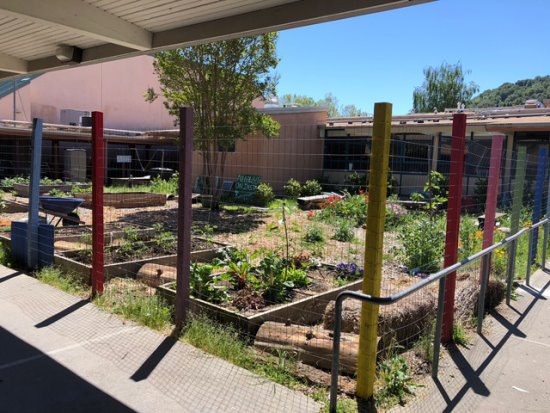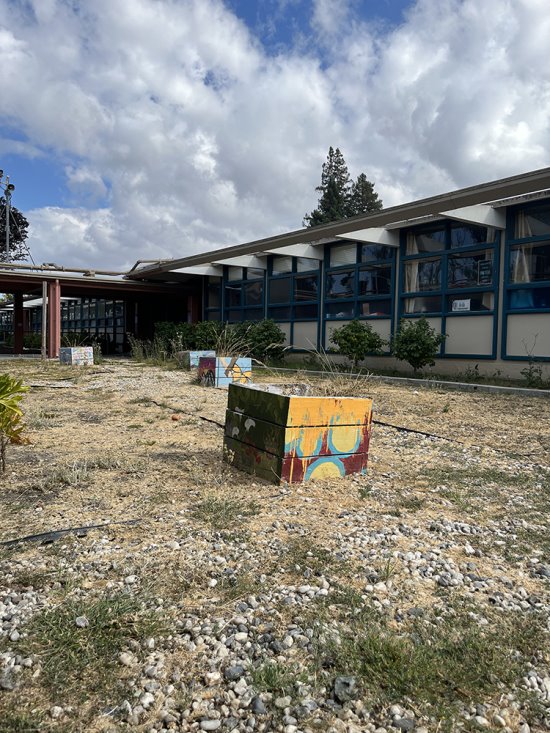 | | | One of the gardens at Miramonte High School, pre-pandemic Photo provided | | | | | | Longtime Orinda resident and garden volunteer Linda Mizes was in a state of shock after her first visit to Miramonte High School post-pandemic. The three gardens, scattered throughout the school, in which she, along with many other volunteers, dedicated nearly two decades of strenuous volunteer work, had disappeared, along with several Eagle Scout projects and thousands of dollars in grants.
 "Times are changing now, and there are different priorities. But a number of years ago, school gardens were a wonderfully big thing," Mizes said.
"Times are changing now, and there are different priorities. But a number of years ago, school gardens were a wonderfully big thing," Mizes said.
 In 2020, Miramonte boasted three thriving gardens. The first one stood next to the tennis courts.
In 2020, Miramonte boasted three thriving gardens. The first one stood next to the tennis courts.
 Mizes originally started it as a vegetable garden in 2004, but through years of hard work, volunteers converted it into a thriving permaculture food forest-a mostly self-sustaining garden. Students, parents, and teachers filled the garden with benches, raised beds, a garden shed and a compost bin built as Eagle Scout projects, fruit trees donated by the Moraga Garden Center, and even a greenhouse donated by the Lafayette Garden Club. However, today, all of this is gone, leaving only a pile of the stones, which used to line a path through the garden, and the fruit trees, which are desperately in need of tending.
Mizes originally started it as a vegetable garden in 2004, but through years of hard work, volunteers converted it into a thriving permaculture food forest-a mostly self-sustaining garden. Students, parents, and teachers filled the garden with benches, raised beds, a garden shed and a compost bin built as Eagle Scout projects, fruit trees donated by the Moraga Garden Center, and even a greenhouse donated by the Lafayette Garden Club. However, today, all of this is gone, leaving only a pile of the stones, which used to line a path through the garden, and the fruit trees, which are desperately in need of tending.
 "I had no idea that this happened. I talked to some other people, and they also had no idea this happened," Mizes said.
"I had no idea that this happened. I talked to some other people, and they also had no idea this happened," Mizes said.
 The second garden was called the Contemplative, or Meditation Garden, and the volunteers designed it to be a safe, calming space for students to hang out with friends or decompress alone. To construct this space, in 2018, the Lafayette Garden Club granted Christina Orangio, the former horticultural program instructor, $2,000 to carry out her vision. This space consisted of planter boxes, various seating areas, and plants donated by parents and other volunteers. Only the planter boxes, which were painted beautifully by students, stand today, barren and scattered around the dirt area.
The second garden was called the Contemplative, or Meditation Garden, and the volunteers designed it to be a safe, calming space for students to hang out with friends or decompress alone. To construct this space, in 2018, the Lafayette Garden Club granted Christina Orangio, the former horticultural program instructor, $2,000 to carry out her vision. This space consisted of planter boxes, various seating areas, and plants donated by parents and other volunteers. Only the planter boxes, which were painted beautifully by students, stand today, barren and scattered around the dirt area.
 The third garden was a vegetable garden consisting of nine raised beds, four or five wheelbarrows, a path made of stepping stones, a sturdy fence, a garden shed, and a newly donated Eagle Scout-built compost bin. Today, all this material is gone, with the exception of the garden shed sitting in the corner.
The third garden was a vegetable garden consisting of nine raised beds, four or five wheelbarrows, a path made of stepping stones, a sturdy fence, a garden shed, and a newly donated Eagle Scout-built compost bin. Today, all this material is gone, with the exception of the garden shed sitting in the corner.
 "It's not as if the school is tearing down its own equipment. This was provided and paid and assembled by other people, not by the school itself. It was a gift, and these other people were not going to be too happy having their donations destroyed," Mizes said.
"It's not as if the school is tearing down its own equipment. This was provided and paid and assembled by other people, not by the school itself. It was a gift, and these other people were not going to be too happy having their donations destroyed," Mizes said.
 The reasons why the school and district decided to remove the gardens are unclear. "Although they may have been in good shape many years ago, over the years the weeds and plants became overgrown, the benches, fencing, greenhouse, and beds were falling apart and unsafe, the vegetables were growing in chemically treated beds, and the terrain was not ADA compliant nor safe for anyone," Miramonte Principal Ben Campopiano said.
The reasons why the school and district decided to remove the gardens are unclear. "Although they may have been in good shape many years ago, over the years the weeds and plants became overgrown, the benches, fencing, greenhouse, and beds were falling apart and unsafe, the vegetables were growing in chemically treated beds, and the terrain was not ADA compliant nor safe for anyone," Miramonte Principal Ben Campopiano said.
 However, Mizes insists that, due to the lack of care and water, it is unlikely the plants became overgrown and that much of the garden's equipment was recently installed and was still in good shape in 2020. Additionally, she says that they never used chemically treated wood because they kept their gardens organic, and, under the supervision of a previous principal, they ensured the gardens were ADA-compliant.
However, Mizes insists that, due to the lack of care and water, it is unlikely the plants became overgrown and that much of the garden's equipment was recently installed and was still in good shape in 2020. Additionally, she says that they never used chemically treated wood because they kept their gardens organic, and, under the supervision of a previous principal, they ensured the gardens were ADA-compliant.
 Nevertheless, both Mizes and Campopiano agree that the plan is to rebuild back, better than ever. "I will be working with interested parents, students, staff, and community members to help bring these gardens back to life," Campopiano said.
Nevertheless, both Mizes and Campopiano agree that the plan is to rebuild back, better than ever. "I will be working with interested parents, students, staff, and community members to help bring these gardens back to life," Campopiano said.
 Having access to school gardens in high school is important because, along with their positive aesthetic and environmental effects, experts say gardens are also beneficial for overall student health. "Working in a garden can lead to reduced stress, more positive mental state, and physical health and well-being," a study by the Journal of American College Health states. During a time when teenagers are under heavy social and academic pressure, finding ways to relieve stress is more important than ever.
Having access to school gardens in high school is important because, along with their positive aesthetic and environmental effects, experts say gardens are also beneficial for overall student health. "Working in a garden can lead to reduced stress, more positive mental state, and physical health and well-being," a study by the Journal of American College Health states. During a time when teenagers are under heavy social and academic pressure, finding ways to relieve stress is more important than ever.
 "For 20 years, I've taught nature and gardening to students. It's important to eat healthily, and it's important to work in a garden and know how things grow," Mizes said. "My hope is that we can make these sites more conducive and more useful to the students."
"For 20 years, I've taught nature and gardening to students. It's important to eat healthily, and it's important to work in a garden and know how things grow," Mizes said. "My hope is that we can make these sites more conducive and more useful to the students." |

